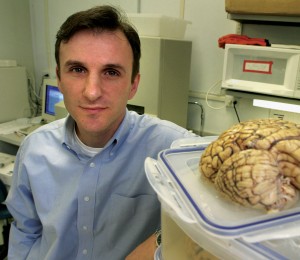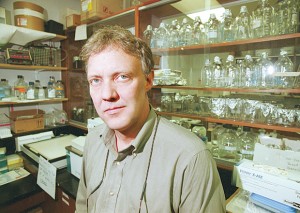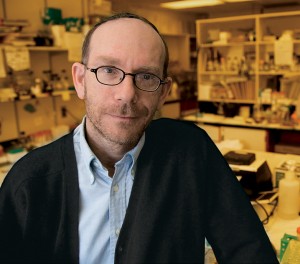By Mark Reynolds
What is the link between child abuse and adult suicide risk? A startling new study suggests that physical and emotional child abuse makes dramatic and long-lasting changes to young male victims’ brains—increasing the odds that they’ll grow up to become men who commit suicide.

In the wake of a suicide, friends, family and loved ones are left reeling, grappling with the big question: Why? One part of the answer was recently found in research performed by scientists associated with the newly formed Sackler Program for Epigenetics and Psychobiology at McGill University. The researchers discovered a novel biological link to some male suicides. Earlier studies linked physical or emotional childhood abuse to suicide, but the Sackler team found that childhood abuse amongst suicide victims was associated with a distinct epigenetic mark on the DNA. The discovery represents a huge step forward for epigenetics—the study of how environmental factors change gene expression—and holds the promise of better understanding suicide and, perhaps, new treatments.
This discovery grew out of a grim, yet indispensible, resource. The Quebec Suicide Brain Bank is exactly what it sounds like: dozens of brain tissue samples from suicide victims, each preserved in Pyrex containers in a Douglas Mental Health University Institute freezer. Every time the Quebec Coroner’s office determines a death to be a suicide, it notifies psychiatry professor Dr. Gustavo Turecki, director of the McGill Group for Suicide Studies at the Douglas. Researchers from the MGSS then contact the next of kin to ask whether they are willing to donate a brain tissue sample. But the researchers are interested in more than just the brain; they want to know the person it came from. Using standardized and validated interviews with friends, family and spouses, they build a complete psychological and medical history of each victim.
Beginning in 2006, Patrick McGowan, a post-doctoral fellow in medicine professor Michael Meaney’s lab, was given access to this wealth of information—and, of course, the brains. McGowan had just returned to Montreal (he did his undergraduate studies at Concordia University) after completing his PhD at Duke University in North Carolina. He was specifically attracted by Meaney’s collaborations with Moshe Szyf, the James McGill Professor in the Department of Pharmacology and Therapeutics. In a now-famous 2004 paper published in the journal Nature Neuroscience, Meaney and Szyf showed that gene expression in rat pups could be affected by maternal care in infancy. The more licking and grooming from the mother, the less anxious the offspring, behavioural changes that correlated with gene expression. The DNA sequence of the rats was unchanged, of course; what was different was the methylation, a chemical coating on the DNA that determines how our genes work.
Meaney and Szyf worked exclusively with rat models, and McGowan was excited by the prospect of taking epigenetics to the next level. Back at the Douglas, Turecki had been following Meaney and Szyf’s research, and saw how the Quebec Suicide Brain Bank could be useful. “It became clear to me that we were in a good position to do translation work,” he says. “This was a good opportunity to test the theories from animal work and see if they were applicable to humans.”
“I had never expected to have a chance to work with human samples,” McGowan says. “But the feeling was that if we can do this in animals, why not in humans? We had the brains, and we had the histories.”
McGowan’s team used a cohort of 36 brain samples. One third were from suicide subjects who were known to have been abused in childhood, one third from suicides with no known abuse in their childhoods, and one third from a control group. The researchers discovered that those suicides who had suffered abuse as children bore specific epigenetic methylation characteristics absent on specific DNA sites that were in the other two groups. Significantly, those marks were shown to influence the hypothalamic-pituitary-adrenal (HPA) function.

The HPA axis is a critical feature of the stress response. It is managed by a set of genes expressed in the hippocampus, including one that was epigenetically marked by the experience of childhood abuse. Abnormal HPA activity in response to stress is in turn strongly linked to suicidal action. Turecki explains that there was no distinction made in their cohorts between severity or nature of the childhood abuse: “Severity is a subjective thing—the impact is much more important.”
The study was published in the February 22 issue of Nature Neuroscience. The McGill research team also includes graduate students Ana C. D’Alessio and Benoît Labonté, research associate Aya Sasaki and research technician Sergiy Dymov. Suicide’s links to stress and childhood abuse were both known before, but this breakthrough demonstrates, at least in part, exactly how it works on a biological level. Turecki is careful to avoid speculation about future treatments, but he allows that this is a significant step “toward understanding how early life experiences have a major impact on mental health.”

Epigenetics points to a way forward. McGowan believes that epigenetic patterns could serve as a valuable diagnostic tool, if markers can be detected in blood tests. Better yet, it may be possible to manipulate the methylations themselves, thus reversing their unwanted effects. The drug TSA and l-methionine infusions (directly into the brain) have already proved successful in changing methylation patterns established early in a rat’s early life. “The l-methionine infusions are particularly interesting,” says McGowan, “because l-methionine is an essential amino acid and a popular nutritional supplement. The studies showed effects in adult animals so it’s possible that, at some point in the future, therapies might include drugs that change epigenetic patterns in the brain. The key would be to discover how to target these drugs, which have widespread effects, to the right genes. It would be equally interesting to know whether social interventions have protective effects by changing the methylation of certain key genes.”

Moshe Szyf, who was recently appointed to the inaugural GlaxoSmithKline-CIHR Professorship in Pharmacology, says that this study is the first that he knew of in which there is a clear link between human social environments and their epigenetic code. “It is dynamic, and it acts through life,” he says. “And it’s not just chemicals that affect these mechanisms, it’s the social, and even political, environment.” This recent breakthrough raises many more questions about this mysterious relationship between environment and DNA. If a person’s genes can be affected by childhood abuse, then what about the effect on those who’ve grown up in countries that have endured decades of war and oppression? What effect does diet, or even music, have on our DNA? If the social environment has such an effect on who we are, there is almost no area of human endeavour without a potential impact on our epigenetic code. “To understand human health and disease, we must study humans in their true environmental context.”
As for the age-old nature-versus-nurture debate? Well, epigenetics just might offer a third choice: both. Medical research has long known that, despite having identical DNA sequences, the health and personality of identical twins often diverge. Environmental influences are often used to explain such inconsistencies in genes and traits—now this new study shows that the environment can actually direct alter the activity of the genome.
“Nature and nurture has always been a false dichotomy,” says McGowan, before quoting famed McGill neuroscientist Donald Hebb: “It’s like asking which is more important to a rectangle’s area—length or width?”
This research was funded by the Canadian Institutes for Health Research and the U.S. National Institute of Child Health and Development.
